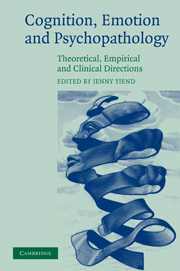Book contents
- Frontmatter
- Contents
- List of contributors
- An introduction and synthesis
- Andrew Mathews: a brief history of a clinical scientist
- Part I Theoretical approaches
- Part II Empirical directions
- Part III Clinical perspectives
- 10 Maintenance mechanisms in social anxiety: an integration of cognitive biases and emotional processing theory
- 11 Mental imagery and social phobia
- 12 Experimental cognitive psychology and clinical practice: autobiographical memory as a paradigm case
- 13 Mindfulness-based cognitive therapy
- 14 Clinical difficulties to revisit
- Index
13 - Mindfulness-based cognitive therapy
Published online by Cambridge University Press: 23 November 2009
- Frontmatter
- Contents
- List of contributors
- An introduction and synthesis
- Andrew Mathews: a brief history of a clinical scientist
- Part I Theoretical approaches
- Part II Empirical directions
- Part III Clinical perspectives
- 10 Maintenance mechanisms in social anxiety: an integration of cognitive biases and emotional processing theory
- 11 Mental imagery and social phobia
- 12 Experimental cognitive psychology and clinical practice: autobiographical memory as a paradigm case
- 13 Mindfulness-based cognitive therapy
- 14 Clinical difficulties to revisit
- Index
Summary
One of Andrew Mathews' most important contributions to our field has been the demonstration that anxiety is associated with an attentional bias towards threat-related material. This bias provides a plausible basis for understanding the origins and maintenance of anxiety-related disorders in terms of self-perpetuating, interacting processes: selective attention to threat means that experience is more likely to be interpreted in threatening ways; these interpretations will generate further anxiety; that anxiety will reinforce the attentional bias, and so on.
From this perspective, it might seem counterproductive, even foolish, to train anxious patients to deliberately focus their attention towards unpleasant aspects of their experience. And yet this is a central component of the application of mindfulness training to emotional disorders, and there is encouraging evidence (reviewed by Baer, 2003) that such training can reduce symptoms of generalized anxiety disorder (GAD) and panic. Clearly, there is more than one way we might attend to unpleasant aspects of our experience. For example, we might attend to our unpleasant experience as if we were a scientist, curious about the precise nature of the constellation of thoughts, feelings and body sensations that comprise the experience; or, we might attend to the unpleasant experience as revealing an aspect of ourselves that we loathe and despise; or, indeed, we might attend to the unpleasant experience as a potential threat to our physical or mental well-being. In this chapter, I will consider how mindfully attending to unwanted experience may alleviate, rather than exacerbate, emotional disorders. Mindfulness, here, means ‘paying attention in a particular way: on purpose, in the present moment, and nonjudgmentally’ (Kabat-Zinn, 1994, p. 4).
- Type
- Chapter
- Information
- Cognition, Emotion and PsychopathologyTheoretical, Empirical and Clinical Directions, pp. 270 - 289Publisher: Cambridge University PressPrint publication year: 2004
- 33
- Cited by



